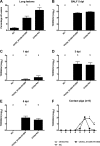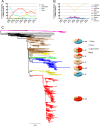The Molecular Determinants of Antibody Recognition and Antigenic Drift in the H3 Hemagglutinin of Swine Influenza A Virus
- PMID: 27384658
- PMCID: PMC5008105
- DOI: 10.1128/JVI.01002-16
The Molecular Determinants of Antibody Recognition and Antigenic Drift in the H3 Hemagglutinin of Swine Influenza A Virus
Abstract
Influenza A virus (IAV) of the H3 subtype is an important respiratory pathogen that affects both humans and swine. Vaccination to induce neutralizing antibodies against the surface glycoprotein hemagglutinin (HA) is the primary method used to control disease. However, due to antigenic drift, vaccine strains must be periodically updated. Six of the 7 positions previously identified in human seasonal H3 (positions 145, 155, 156, 158, 159, 189, and 193) were also indicated in swine H3 antigenic evolution. To experimentally test the effect on virus antigenicity of these 7 positions, substitutions were introduced into the HA of an isogenic swine lineage virus. We tested the antigenic effect of these introduced substitutions by using hemagglutination inhibition (HI) data with monovalent swine antisera and antigenic cartography to evaluate the antigenic phenotype of the mutant viruses. Combinations of substitutions within the antigenic motif caused significant changes in antigenicity. One virus mutant that varied at only two positions relative to the wild type had a >4-fold reduction in HI titers compared to homologous antisera. Potential changes in pathogenesis and transmission of the double mutant were evaluated in pigs. Although the double mutant had virus shedding titers and transmissibility comparable to those of the wild type, it caused a significantly lower percentage of lung lesions. Elucidating the antigenic effects of specific amino acid substitutions at these sites in swine H3 IAV has important implications for understanding IAV evolution within pigs as well as for improved vaccine development and control strategies in swine.
Importance: A key component of influenza virus evolution is antigenic drift mediated by the accumulation of amino acid substitutions in the hemagglutinin (HA) protein, resulting in escape from prior immunity generated by natural infection or vaccination. Understanding which amino acid positions of the HA contribute to the ability of the virus to avoid prior immunity is important for understanding antigenic evolution and informs vaccine efficacy predictions based on the genetic sequence data from currently circulating strains. Following our previous work characterizing antigenic phenotypes of contemporary wild-type swine H3 influenza viruses, we experimentally validated that substitutions at 6 amino acid positions in the HA protein have major effects on antigenicity. An improved understanding of the antigenic diversity of swine influenza will facilitate a rational approach for selecting more effective vaccine components to control the circulation of influenza in pigs and reduce the potential for zoonotic viruses to emerge.
Copyright © 2016, American Society for Microbiology. All Rights Reserved.
Figures



Similar articles
-
Substitutions near the hemagglutinin receptor-binding site determine the antigenic evolution of influenza A H3N2 viruses in U.S. swine.J Virol. 2014 May;88(9):4752-63. doi: 10.1128/JVI.03805-13. Epub 2014 Feb 12. J Virol. 2014. PMID: 24522915 Free PMC article.
-
Evolution and Antigenic Advancement of N2 Neuraminidase of Swine Influenza A Viruses Circulating in the United States following Two Separate Introductions from Human Seasonal Viruses.J Virol. 2021 Sep 27;95(20):e0063221. doi: 10.1128/JVI.00632-21. Epub 2021 Aug 11. J Virol. 2021. PMID: 34379513 Free PMC article.
-
Novel Reassortant Human-Like H3N2 and H3N1 Influenza A Viruses Detected in Pigs Are Virulent and Antigenically Distinct from Swine Viruses Endemic to the United States.J Virol. 2015 Nov;89(22):11213-22. doi: 10.1128/JVI.01675-15. Epub 2015 Aug 26. J Virol. 2015. PMID: 26311895 Free PMC article.
-
Antibody Immunodominance: The Key to Understanding Influenza Virus Antigenic Drift.Viral Immunol. 2018 Mar;31(2):142-149. doi: 10.1089/vim.2017.0129. Epub 2018 Jan 22. Viral Immunol. 2018. PMID: 29356618 Free PMC article. Review.
-
Towards a universal influenza vaccine: different approaches for one goal.Virol J. 2018 Jan 19;15(1):17. doi: 10.1186/s12985-017-0918-y. Virol J. 2018. PMID: 29370862 Free PMC article. Review.
Cited by
-
Machine Learning Prediction and Experimental Validation of Antigenic Drift in H3 Influenza A Viruses in Swine.mSphere. 2021 Mar 17;6(2):e00920-20. doi: 10.1128/mSphere.00920-20. mSphere. 2021. PMID: 33731472 Free PMC article.
-
PARNAS: Objectively Selecting the Most Representative Taxa on a Phylogeny.Syst Biol. 2023 Nov 1;72(5):1052-1063. doi: 10.1093/sysbio/syad028. Syst Biol. 2023. PMID: 37208300 Free PMC article.
-
Reduction of Influenza A Virus Prevalence in Pigs at Weaning After Using Custom-Made Influenza Vaccines in the Breeding Herds of an Integrated Swine Farm System.Viruses. 2025 Feb 10;17(2):240. doi: 10.3390/v17020240. Viruses. 2025. PMID: 40006995 Free PMC article.
-
Detection and characterization of an H4N6 avian-lineage influenza A virus in pigs in the Midwestern United States.Virology. 2017 Nov;511:56-65. doi: 10.1016/j.virol.2017.08.021. Epub 2017 Aug 23. Virology. 2017. PMID: 28841443 Free PMC article.
-
Heterologous Antibody Responses Conferred by A(H3N2) Variant and Seasonal Influenza Vaccination Against Newly Emerged 2016-2018 A(H3N2) Variant Viruses in Healthy Persons.Clin Infect Dis. 2020 Dec 15;71(12):3061-3070. doi: 10.1093/cid/ciz1203. Clin Infect Dis. 2020. PMID: 31858129 Free PMC article.
References
-
- U.S. Department of Agriculture. 2007. Swine 2006. Part II: reference of swine health and health management practices in the United States, 2006. U.S. Department of Agriculture, Fort Collins, CO.
Publication types
MeSH terms
Substances
Grants and funding
LinkOut - more resources
Full Text Sources
Other Literature Sources
Molecular Biology Databases

